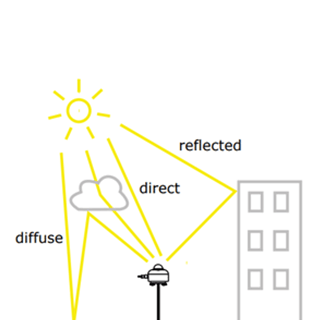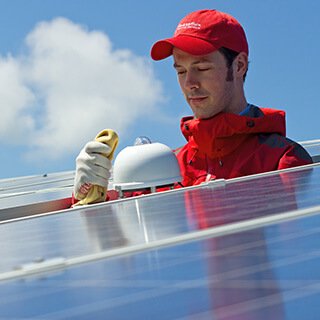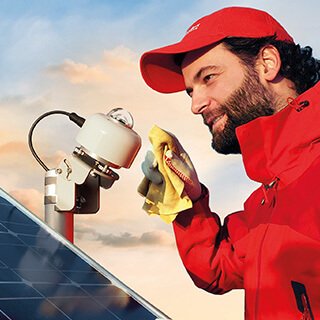Solar radiation sensors: become a pyranometer expert
Have you always wondered how pyranometers work? In this article, we will explain everything you need to know. We start with a short introduction about what pyranometers are and how they are used. After that, we continue with the working principles of the sensor, a simple explanation of the physics. We at Hukseflux made multiple improvements to pyranometer technology, leading to more accurate measurements. We will comment on three of the most important improvements, showing you how they work and explaining the benefit for the user.
What is a pyranometer?
A pyranometer is a solar radiation sensor that measures the radiation received by a surface in Watts per square metre (W/m²). Pyranometers are designed to measure solar irradiance in the wavelength range of (285 to 3000) x 10⁻⁹ m. This range contains all the radiation that comes directly from the sun, not the longwave infrared atmospheric radiation. The word “Irradiance” is used interchangeably with the more informal “radiation” as both refer to the radiation measured by a sensor. The sensor is designed to measure W/m² across the entire spectrum, without any variations in weight between wavelengths. If this condition is met, the sensor is called “spectrally flat”.
We offer a wide range of pyranometers, suitable for different applications. Pyranometers are traditionally used for meteorological observations. They can also be used to monitor PV system performance. Pyranometers are also used in agriculture to optimise plant growth or in building planning to make buildings like houses more energy efficient.
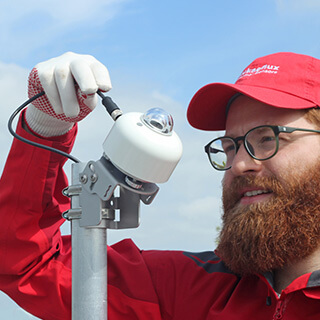
solar radiation in Plane of Array (POA) for
PV system performance monitoring.
Here at Hukseflux, we make thermopile pyranometers. These sensors use thermopiles to measure solar irradiance. Other types of pyranometers use silicon photodiodes. Using a thermopile rather than a silicon photodiode has many advantages; wider spectral range, more stable response over time, and higher accuracy.
Curious how this thermopile technology works? Keep reading to find out.
The physics behind thermopile pyranometers
Multiple physical concepts are used to ensure the best irradiance measurement in thermopile pyranometers.
The first one is the cosine characteristic, also known as the cosine response. The amount of solar radiation a pyranometer receives, changes with the angle of incoming sunlight. When the sun is at its highest point, the solar radiation sensor should have a full response, because all the sunlight hits the surface directly. At this point, the zenith angle (angle between the surface normal and the beam of sunlight) is zero. When the sun is at the horizon, the angle is 90 degrees, which should give no response, because no sunlight hits the surface. During the day, the sunlight will hit the sensor at different angles. To make sure the measurement is still correct, the sensor should take this angle into consideration.
This relation is called the ideal cosine characteristic, defined by the following formula:
![]()
Theta (θ) is the zenith angle and R is the radiation the surface receives, with R0 the actual amount of radiation the sun emits.
The measurement of solar radiation with the pyranometer should be as close as possible to this “cosine response“ relation for the best irradiance measurement.
The solar irradiance the sensor receives is transferred to heat by black coating deposited on the surface of the thermopile sensor. More on that in the next paragraph. To measure the heat and thus the radiation, a thermopile sensor is used. The thermopile consists of multiple small thermocouples. These thermocouples consist of two different metals. One junction between these materials is kept at a colder temperature, like sensor metal-body temperature. The other joints are placed at the black coating, which is relatively hot because of the heat generated by the solar radiation. If over two different contact points of both materials, there is a temperature difference, this generates a voltage output because of the Seebeck effect, also called the thermoelectric effect.
The temperature difference generates a small voltage, according to the following formula:
![]()
The generated voltage is proportional to the temperature difference between the hot (Tw) and cold joints (Tc). Free electrons start moving to a colder place, generating this voltage. When electrons are heated, they begin to move faster. And just like most people, electrons like to use the least amount of energy possible.
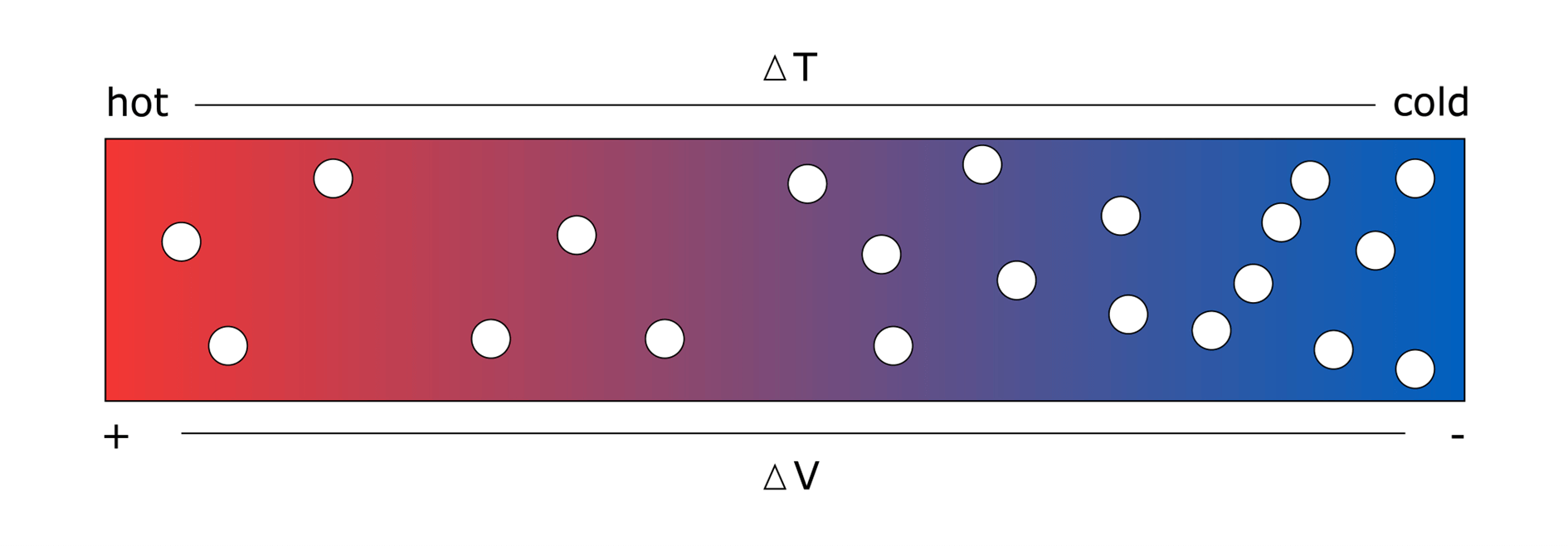
a material is heated up and the Seebeck effect occurs.
To conclude, the solar irradiance is derived from a temperature difference. So, pyranometers are in fact highly advanced temperature difference meters. More information about how a thermopile works in a heat flux sensor can be found in the article: How to measure heat flux?
The components of a pyranometer
All of these physical concepts described in the previous paragraph were used in the design of the pyranometers at Hukseflux. Figure 3 shows an overview of the components of one of our best pyranometers, the SR30.
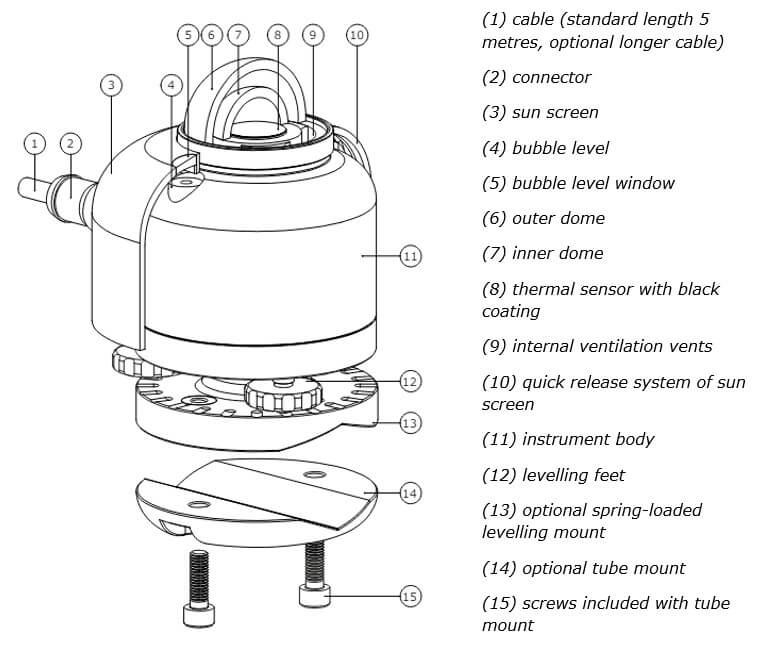
First of all, there is the thermal sensor with black coating (8). The coating is the place where the solar radiation is transferred into heat. The solar radiation is absorbed into the sensor, since it is black-coated. Before the radiation hits the black-coated thermal sensor, it passes through a dome, and in the case of the SR30, two domes (6 and 7). These domes make sure that the sensor only measures the wavelengths coming from solar radiation. There are a few clever advantages to these domes, more on that later in the article.
Between the two domes, there are internal ventilation vents; air is flowing. An internal ventilation system provides an even more accurate measurement. We explain the importance of this feature in the next paragraph.
The other components not mentioned above are mostly used to mount the pyranometer.
The improvements
We at Hukseflux constantly improve our sensors to ensure a better measurement result. One of the most important things we wanted to improve, was to get rid of unwanted thermal exchange processes. Only the solar radiation should heat up the black coating, not the environment or the sensor body itself. We succeeded in that, but of course, our pyranometers have undergone more improvements. Bellow, we summarise the three most important ones.
1. Two domes
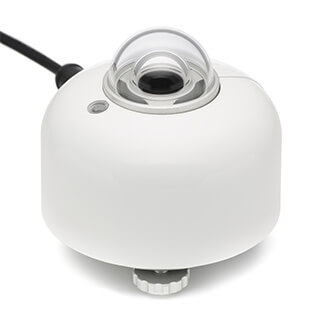
Not all pyranometers on the market have two domes, but one that does have this feature is our SR30. The SR30 is a spectrally flat, class A pyranometer. All pyranometers are subdivided into three classes; A, B and C. Class A has the highest accuracy, while class C has the lowest. The ISO 9060 pyranometer classification standards define these classes. To reach the requirements for a class A pyranometer, two domes are necessary.
The first dome protects the black sensor surface from radiation other than solar radiation and protects the thermopile from convective air.
The first dome keeps the longer wavelengths that do not originate from the sun outside. This infrared radiation would otherwise cool the sensor, resulting in an offset and an underestimation of solar irradiance. The insulation against infrared radiation gets even better when more domes are added, so a second one is placed over the first dome in high-accuracy pyranometers.
There is also convective heat flux between the sensor and the air around it. The first dome acts as a barrier to reduce or even prevent this. Lastly, the outside dome provides protection against rain and dust.
2. Heating and ventilation
Heating and ventilating the instrument ensures smaller temperature gradients throughout the sensor and sensor body. The technology used in the SR30 pyranometer is called Recirculating Ventilation and Heating (RVH™). Heated air is circulated between the inner and outer dome. It is a closed circuit, so the air doesn’t come in contact with the outside air, and as a result doesn’t cool down. Not only is the RVH™ technology more effective than other methods; it is also more power efficient and requires less maintenance.
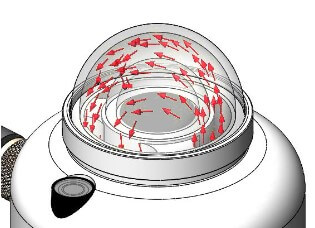
heated air between the two domes.
Because the sensor and dome are in perfect thermal equilibrium, there is a reduction in offsets. Offsets occur when there is an output signal despite the absence of radiation. We need to reduce these offsets as much as possible for accurate measurements. The heated domes also prevent frost and dew deposition, resulting in accurate irradiance measurements throughout the entire year.
Not all pyranometers have a built-in heater like the SR30. For sensors without a heater, external ventilation can be added. For example, with the VU01 ventilation unit. However, this gives a less accurate result and requires more power.
3. Tilt sensor
The tilt sensor, which can be found in the SR30, can detect changes in instrument installation. The tilt sensor measures the gravitational acceleration on three axes. From this measurement, it can calculate the tilt angle. The measurement can be checked remotely for easier maintenance. The sensor is temperature dependent, but has been calibrated and temperature-compensated between -30 and 50 °C. The measurement can also be used to see at what angle the sensor is mounted for POA measurements.
Conclusion
Pyranometers are used to measure solar irradiance. This measurement can be useful for a broad variety of applications. Pyranometers work using a thermopile sensor. The thermopile can transform the radiation from a temperature difference to a voltage, thanks to the Seebeck effect. To ensure that Hukseflux thermopile pyranometers work optimally, we added multiple improvements; two domes, heating and ventilation, and a tilt sensor. We offer a wide range of pyranometers. For the best overview of all options, take a look at our website. Or contact us if you need help choosing the right pyranometer for your application.








